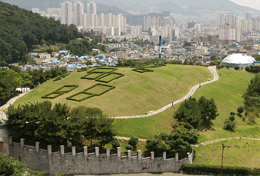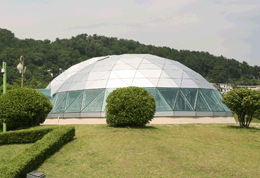
As the only one group of tombs of the ruling class in Busan before the 6th Century, the Bokcheon-dong Ancient Tombs is the relic that vividly shows us the prosperity of Gaya cultures and the process how Gaya was incorporated into Silla. The estimated size of the ancient tombs is 60m in height above the sea level, 700m in length, and 80~10m in width. The ancient tombs are closely distributed on the hills extended long to the South-west from the center of Maan mountain in the North of the downtown street of Dongnae.

The Bokcheon-dong Ancient Tombs aroused interest to the academic world when the Museum of Dong-A University performed a research into the No.1 tomb. Then, in 1980, as the Bokcheon-dong was nominated by Busan City as the housing improvement project area, a full-scale investigation research was carried out. In consequence of such research, the Bokcheon-dong tombs turned out to be very important in explaining about both the Gaya cultures and the history and cultures of Busan in the period of Three Kingdoms. In this connection, Busan City prepared a plan both to purify the ancient tombs and to develop the area as a park. Thereafter, through 2nd, 3rd and 4th excavation research, they could find out the nature of the relics and got to understand the process of cultural development.
In the 5th excavation research, as part of the city planning to preserve and purify the ancient tombs, they excavated the sites where they were going to build a wall, a rear gate and an outdoor exhibition center. Finally, on Oct. 5, 1996, they opened the Bokcheon Museum, an annex to the Busan Municipal Museum(or the Busan Museum), and exhibited there the relics that had been excavated. As for the locations of old structures that had been excavated, they were marked by planting boxwood trees. Since then, in 1997 and 1998, two(2) excavation researches were performed to carry out the extension works in respect of the access road to Bokcheon Museum and its surrounding roads, and additional 28 tombs were found in consequence of such excavation researches.
The total number of old structures that have been examined in the Bokcheon-dong tombs is 169, including 9 wooden coffin tombs, 75 separate wooden box tombs, 17 wooden box tombs with another coffin containing grave goods, 4 jar coffin tombs, 8 pit-type stone coffin tombs with another coffin for grave goods, 55 separate pit-type stone coffin tombs, 1 front opening-type stone coffin tomb, etc. Looking into the distribution of the old structures, on the peak of the hills were lying large sized tombs with coffins containing grave goods, and in the neighboring slopes of the hills were lying small sized tombs without coffins to contain the grave goods. In general, the tombs in the central area were built in consecutive order, from south to north of the hills. As a whole, the wooden coffin tomb was installed in the area from lower to middle part of the hills, and the pit-type stone coffin tombs were installed in the area from middle to the peak part of the hills, and the front opening-type stone coffin tomb was installed in the lower part of the hills after braking a wooden coffin tomb.
In the remains that have been excavated from those tombs are include more than 2,500 pieces of earthenware including shoes-form earthenware, more than 2,720 metal machines and implements including iron armor, more than 4,010 pieces of personal ornaments including gilt-bronze crown and more than 10 other remains including an instrument made of bone. In addition to these, five skeletons of human being, 7 pieces of animal bone including the teeth of a horse, etc were found. Especially, the remains of earthenware both of Haman origin and of Japan origin, which were excavated from the No.57 ancient tomb, not only show us the true character of the cultures at that time but are the important materials to investigate and reveal the overseas exchanges in that period. In addition to this, the large quantity of armors and horse harnesses excavated from the tomb are the basis that reveals the political situation at that time.

Through the method to build a tomb as well as through the items that are exhibited in the Outdoor Exhibition Center, we may get a sense of the burial culture at that time. In the ancient tombs surrounding the Outdoor Exhibition Center, a boxwood trees was planted on the top to indicate the location of the typical tomb that have been researched and excavated.